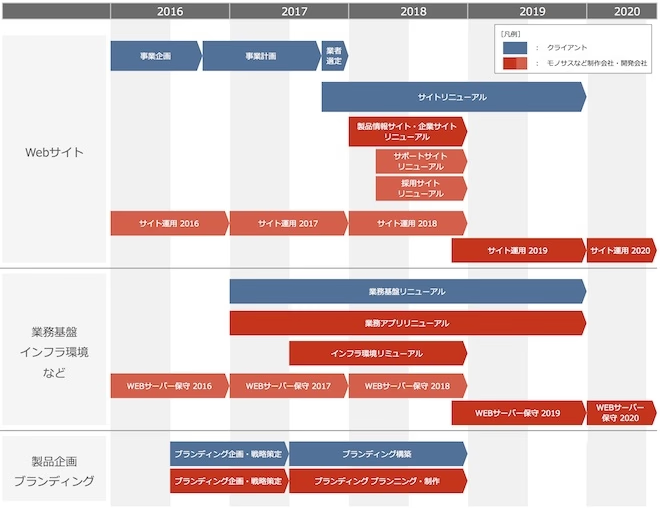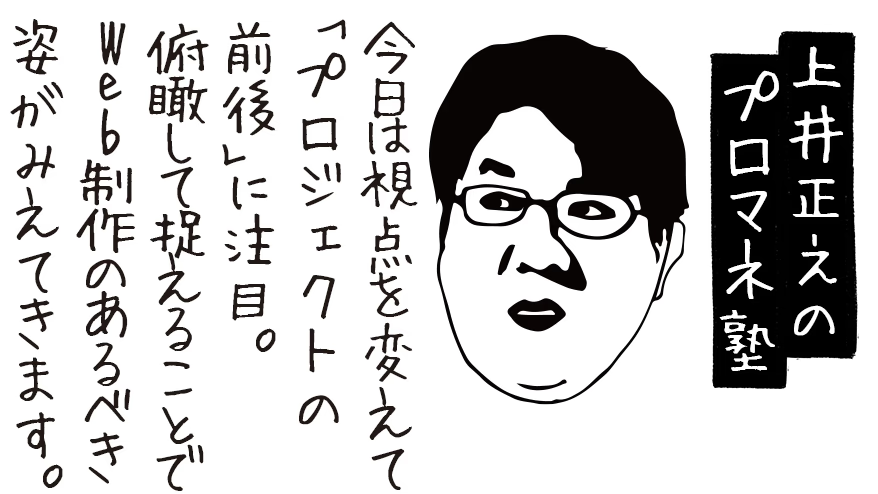こんにちはプロデュース部の上井です。
今回で6回目となる「プロマネ塾」の連載。
これまでの5回では、Webサイトの開発・制作のプロジェクトについて、標準モデルや品質マネジメントシステムなど、品質管理の視点からお話をしてきました。
今回は視点を変え、「プロジェクトの前後を知ろう」として、サイト開発・制作のプロジェクトを、俯瞰で見てみようと思います。
連載目次
1.開発工程モデルについて(2017年4月21日公開)
2.WBS構築について その1 プロジェクトの筋道を立てる (2017年6月15日公開)
3.WBS構築について その2 スケジュール・予算を立てる(2017年8月22日公開)
4.品質管理の基礎知識 その1 QCD(Quality, Cost, Delivery)(2017年10月18日公開)
5.品質管理の基礎知識 その2 標準化・品質マネジメントシステム(2018年2月10日公開)
6.プロジェクトの前後を知ろう ( ←今回)
はじめに
Web制作会社であるモノサスが受託するプロジェクトを、俯瞰で捉えて時系列に整理してみます。これを元に、Web制作の前後左右、隣接するプロジェクトについて見ていこうと思います。

1. プロジェクトの「手前」を知る
サイトリニューアルの開発・制作は、「事業化の検討期間(事業企画)」「事業計画の策定(予算計画)」「事業化決定」「業者選定」を経て、プロジェクトがスタートすることになります。
多くの企業において、開発費が数百万〜数千万の予算規模のプロジェクトを具体化するために、1年以上の期間をかけて予算化をしています。また、開発・制作の予算の他に、クライアント側のプロジェクトチームの予算、後述するインフラ構築や業務フロー刷新のための予算なども必要です。
つまり、サイト開発・制作のプロジェクトは、Webサイトを刷新するプロジェクトを構成する一部ということになります。
大規模サイトのリニューアルでは、製品情報、販売サポート、アフターサービス、企業情報、採用情報など、発信情報のカテゴリーごとに個別のプロジェクトとして立ち上げることも多く見られます。(製品分野ごとに、さらに細分化されたプロジェクトとなることもあります。)
これは、サイト全体の保守・運用管理を行うWebマスターとは別に、サイトの運用更新において、製品のブランディング・販促活動・顧客サポート・採用活動などの主管部署における業務フローとの連携が求められるためです。
2. プロジェクトの「後ろ」を知る
リニューアル実施後のサイトは、現在のサイトとは制作仕様もサイト構造も異なったものとなります。また、リニューアルの開発仕様によっては、サイト更新の際の業務フローが大幅に異なったものになる場合もありえます。
コーポレートサイトを構成する、製品情報、販売サポート、アフターサービス、企業情報、採用情報などの公開情報を決定するのは、それぞれの業務の主管部署です。
例えば、
- 製品情報 :開発部門/製品企画部門(デザイン部門)
- 販売サポート、アフターサービス :販売部門
- 企業情報 :総務部門
- 採用情報 :人事部門
- サイト保守 :システム部門
このように、分掌されていることも多々あります。
製品情報において、製品企画部門によるブランディングが重視されている場合などは、デザイン企画力に長けた制作会社が参画している場合もあります。その場合、制作仕様に対する大きな自由度が求められることもあるでしょう。一方で、制作品質の管理については手放しで良いかもしれません。
一方、販売部門が販売サポート、アフターサービスの充実、対応スピードを高めることを目的とする場合は、Web制作に必要な技術を意識することのない、普段の業務の延長上の道具としての利便性が求められます。また、顧客管理システムや在庫管理システムなどの、業務管理システムとのデータ連携を求められることも考えられます。
これらの業務要件を、クライアントのプロジェクトメンバーとの協働でとりまとめ、開発仕様に落とし込んでいくことが重要となります。
3. 並行するプロジェクトを知る
サイト開発・制作のプロジェクトと連携が必要な、異なるプロジェクトが並行して進行することもあります。
Webサーバーなどのインフラ環境の更新や、サイトからのお問い合わせを一元管理を目的とした顧客管理システムの改修プロジェクトなどです。インフラ環境の更新や、顧客管理システムの改修となると、クライアントのシステム管理部門とシステムベンダーによるプロジェクトであったりします。
スマートフォンの普及により、Javascript を利用した非同期処理を環境を選ばすに利用可能となりました。そのため、サイトからのお問い合わせや、各種資料請求、各種申し込みを上記のシステムと連携させることを要求されることも一般的になっています。
また、サイトリニューアルのタイミングに合わせて、製品プロモーションにおけるブランディング戦略の見直しが行われることもあるでしょう。この場合、サイトにおける製品情報の設計、デザイン制作の段階で、製品企画部門やデザイン部門の確認、承認のプロセスが必要となります。
並行する別プロジェクトとの連携においては、クライアントのプロジェクトメンバーによるクライアント社内における合意形成が、いかにスムーズに進められるかが重要なポイントとなります。
今回は、Webサイトリニューアルのプロジェクトを俯瞰の視点で捉えながら、Web制作会社であるモノサスが受託する、サイト開発・制作に隣接するプロジェクトについてお話ししました。
これら隣接するプロジェクトを連携させるために重要となるのが、プロジェクトの初期段階(要件定義、基本設計)における合意形成や、連携の仕組みづくりです。
次回からは、隣接するプロジェクトを連携させるための、要件定義・基本設計の重要性や、留意点についてお話ししていこうと思います。
それではまた、7月に。
